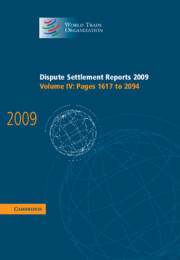Report of the Panel - Annexes
from United States - Continued Existence and Application of Zeroing Methodology (WT/DS350)
Published online by Cambridge University Press: 12 December 2017
Summary
INTRODUCTION
1. The European Communities requests this Panel to rule on an issue which has been found repeatedly inconsistent with WTO rules in previous cases and, in respect of which, the United States has failed to comply with its obligations. Indeed, in recent years, the United States has been subject to intense WTO dispute settlement proceedings contesting the use of zeroing when calculating the margin of dumping for products in anti-dumping proceedings. In all cases, the Appellate Body has clearly interpreted the relevant provisions of the WTO Agreements finding that zeroing as such and as applied by the United States was inconsistent with WTO rules, in particular with the General Agreement on Tariffs and Trade of 1994 (GATT 1994) and the Agreement on Implementation of Article VI of the General Agreement on Tariffs and Trade 1994 (the Anti-Dumping Agreement).
2. In view of this consistent interpretation of the relevant provisions of the WTO Agreements, the European Communities has decided not to ask this Panel to rule again on the WTO inconsistency of the United States' zeroing methodology in original investigations and in review investigations “as such”. The “as such” WTO inconsistency of the methodology has already been successfully established in US – Zeroing (EC) and in US – Zeroing (Japan). Pursuant to Article 17.14 of the Dispute Settlement Understanding, the United States must be considered to have unconditionally accepted the Appellate Body's findings on “as such” zeroing.
- Type
- Chapter
- Information
- Dispute Settlement Reports 2009 , pp. 1619 - 2093Publisher: Cambridge University PressPrint publication year: 2011



